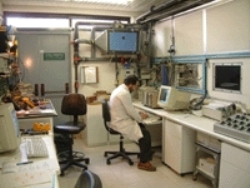A report published in Nature Chemistry explains research conducted by a team from the Universitat Politècnica de Catalunya, the University of Auckland (New Zealand) and the University of Aberdeen (Scotland), using ethanol and sunlight to produce hydrogen. The study is considered to be a big leap in the use of hydrogen to substitute fossil fuels.
 Research Lab
Research Lab
During the research, the team has created a fully scalable powder photo-catalyst to generate hydrogen at ambient heat and pressure, cost-effectively and easily. The team placed the solid photo-catalyst in a container along with ethanol and the container was exposed to ultraviolet light rays by agitation to simulate the most active part of the solar band. The device used a titanium dioxide semiconductor, which when subjected to sunlight produced electrons from the metallic gold nano-particles, in-turn this led to a reaction with the alcohol molecules to generate hydrogen. The arrangement of the semiconductor and the contact with the nano-particles are considered to be important features of this photo-catalyst design.
The quantity of hydrogen and energy produced during the process depended on the quantity of catalyst utilized in the process and the amount of area subjected to solar radiation. The researchers produced around 5 litres of hydrogen by utilising 1kg of the catalyst and a light exposure of one minute. It is estimated that using 9kg of catalyst in the process will generate enough hydrogen for use in a fuel cell to produce 3 kW of electricity, sufficient to conveniently meet the power requirements of a home.
The team also found that the size of the gold nanoparticles used has no relevance in the generation of hydrogen unlike other procedures where the catalyst powder used was heated to a reaction temperature of over 500ºC incurring high level energy costs. Also, the catalyst utilized in the procedure remains more durable because of its exposure to ambient heat and pressure during the process.